#what if we invented a new and incredible niche aesthetic
Explore tagged Tumblr posts
Text
The Warrior Cats Phenomenon
A beloved xenofiction series that is, in reality, incredibly mediocre, is subsequently glamorized and over-inflated by the perception of adolescents, influenced by the cultural landscape at the time of the fandom's mainstream conception. The era of the early 2000s brought about the popularization of the internet, and with it came a new sub-division in alt. youth pop culture; which for the sake of this tangent I will refer to as "Alternative animal expressionism." In less formal terms, just about all the artsy kids on deviantart had a fursona that walked on four legs and was adorned with an abundance of accessories and bright colors, as well as punk/emo-resembling hair styles. This is reflective of the commonplace visual aesthetics we now refer to as MySpace/MyScene subculture. MySpace was designed as a platform for older teenagers and young adults, and just so happened to collide with the rise of Youtube, and with it came two other communities that were skyrocketing in popularity; AMVs and furries. The history of furries is too long to elaborate on here, however many of them were pioneers in developing crucial components of code still used in modern operating systems. What defines a "Furry" is debated, but mostly revolves around an enjoyment of anthropomorphized animals. arguably one of if not the most popular forms of media depicting animals with such characteristics at the time was Walt Disney's The Lion King, and the growing number of forum websites meant that multiple forums and websites were bound to surface that were entirely dedicated to The Lion King and its fans, serving as a dedicated space to discuss the film, and potentially their own fan-made characters. AMV is an incredibly broad and potentially outdated term. The Acronym "AMV" was first coined as "Anime music video." Although for reasons I will touch on a bit later it can also mean "Animated music video." Again, with the notoriety of forum websites and online fan spaces, information can much more easily be found, given, and spread. Anime was still a relatively new concept in the world of Western entertainment (and was first popularized by, you guessed it, Furries.), and until files and videos could easily be shared over the internet, the only way to watch Anime was to get your hands on a physical VHS tape, which at the time still proved to be difficult and an incredibly niche practice, especially if you wanted subtitled or dubbed Anime.
Now in the 2000's, the popularity of Anime has increased almost tenfold. And while animation is a media that can be easily translated is necessary and enjoyed by a Western Audience, Japanese music did not quite reach the same level of popularity, at least not alongside Anime. Western audiences often combined clips of various Anime TV shows and films to music, most of which was Western-made. The intent, editing style, and end result of each fan-made music video often differed greatly from each other, although a common idea was evidently present: The music landscape at the time, brought on by the newest wave of counter culture, could be relatable to the situations of the animated characters. (This was not a completely new concept, and full disclosure I do not know how people made fan made music videos before computer video editing software was invented. According to Wikipedia, "The first AMV was created in 1982 by 21-year-old Jim Kaposztas. [He] hooked up two videocassette recorders to each other and edited the most violent scenes from Star Blazers to "All You Need Is Love" by the Beatles to produce a humorous effect.") These were also sometimes referred to as "Anime mixes", particularly if they contained footage from more than one property. Similar media also included MMVs ("Manga music videos"), FMVs (literally "Fan Music Videos") and HMVs (which were obviously created for a more adult audience).
The oldest AMV on Youtube (at least that I could find) After some time, the appeal of creating a fan-made music video spread to other fandoms (again through social cross-pollination, i.e. someone who was a fan of both Anime and The Lion King was more likely to adopt these mediums), particularly The Lion King, and fan made music videos using footage from the film and its sequels began to surface, although still using the "AMV" Moniker. The next logical step for anyone who enjoyed Western mainstream animation was to include other Disney properties in fan-made music videos. But why stop at mainstream? Why stop at films? the medium soon evolved to contain and pay tribute to all kinds of Western animation, from Walt Disney to cult classics such as the likes of Watership Down, to TV shows like Avatar The Last Airbender (the latter of which was often understandably grouped in with Anime and AMVs). In 2003, a group of authors underneath the pseudonym Erin Hunter released the first book in what would become one of the most popular and most beloved xenofiction book series of all time. Warriors: Into the Wild. Like most budding fandoms, Warrior Cats also sprouted dedicated fan websites for discussion of the series. The up-and-coming Warrior Cats fandom found itself somewhere on the spectrum between the anime and furry communities, combining the ingenuity and creative thinking with the"Sparkledog" furry art style. However, the more "visual" creative types lacked almost any pre-existing media to work with, and before 2009, fan-made music videos often consisted of picture slideshows with simple or non-existent effects and transitions, with some scattered fan-made animations here and there. And then, everything changed when a small team of artists and animators driven purely by devotion, passion, and seemingly sheer creative will, released the first episode of their new Anime-inspired, episodic retelling of the first Warriors book. SSSWarriorCats was so Anime-inspired, both in animation style, direction and pacing, perfectly straddling the balance between the Anime and furry communities, respectfully. The series, although technically incomplete, still garners an enormous fanbase to this day. Evidently Warrior Cats fans have been inspired by these animations for over a decade, and it's not hard to see why. And thus the release and subsequent releases of episodes sparked what is regarded as the “Classic” period in Warrior Cats fan animations, and also sparked the creation of “MAPs” (“Multi-Animator-Projects”), as opportunities to collaborate with fellow artists. To summarize, Warrior Cats had the ingenuity of Anime fans to create music videos out of already-existing content, but upon realizing they had none, looked to the furry, tactile-based artistic side of their fandom’s conception to create it, instead of waiting for an official adaptation to surface. (And considering what Tencent animation is doing… I’m glad they did.) In other, perhaps more unserious terminology, the Warrior Cats fandom is the cultural brainchild of the Anime and Furry communities. To summarize, Warrior Cats had the ingenuity of Anime fans to create music videos out of already-existing content, but upon realizing they had none, looked to the furry, tactile-based artistic side of their fandom’s conception to create it, instead of waiting for an official adaptation to surface. (And considering what Tencent animation is doing… I’m glad they did.) In other, perhaps more unserious terminology, the Warrior Cats fandom is the cultural brainchild of the Anime and Furry communities. The Warrior Cats Fandom continues to persist, even after two decades, seemingly out of sheer artistic will. But, of course, the question remains as to why all of this happened, why does the possibility for these ideas to occur exist in the first place? The answer is simple, The perception of adolescents that such amalgamated fan-made media can be perceived as "mature" or even "edgy" is not one that has disappeared from our culture and probably never will. Cringe culture is dead.
#I'm supposed to be writing about how 'The Boxtrolls' is a digestible allegory for scapegoating and genocide.#BTW most of this is speculation#this is just me rambling about how the fandom only exists because it just so happened to co-exist-#-alongside other internet-defining communities.#dont treat this as a history book cuz the history of the internet is nearly impossible to document in full#blathering#crowfish crap#warrior cats#waca#wc#warriors#warriors erin hunter#erin hunter warriors#warriorcats#xenofiction#tlk#the lion king#amv#internet history#furry community#furry history#fandom history#fandom#favorites#wheeee!#tumblr please work with me here#thanks for coming to my ted talk#I almost exceeded the amount of characters I can put in a post so the ending is a tad bit rushed
19 notes
·
View notes
Text
Tuckcore
moss-covered logs
exploring overgrown forests and abandoned buildings
dusty clocks that always run a little slow
old clothes
sturdy boots
baking (especially enough to share with a neighbor!)
asking questions
climbing trees
adding pockets to clothes!!
holding hands with a friend
collecting stones from river beds
handwritten letters with leaves or tea bags inside
#what if we invented a new and incredible niche aesthetic?#ha ha just kidding .!..#unless?#tuckcore#tuck everlasting#adventurecore#cottagecore
75 notes
·
View notes
Photo
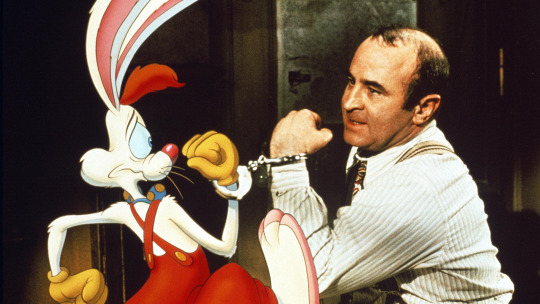
Blurring the Line.
As a new Space Jam film beams down to Earth, Kambole Campbell argues that a commitment to silliness and a sincere love for the medium is what it takes to make a great live-action/animation hybrid.
The live-action and animation hybrid movie is something of a dicey prospect. It’s tricky to create believable interaction between what’s real and what’s drawn, puppeteered or rendered—and blending the live and the animated has so far resulted in wild swings in quality. It is a highly specific and technically demanding niche, one with only a select few major hits, though plenty of cult oddities. So what makes a good live-action/animation hybrid?
To borrow words from Hayao Miyazaki, “live action is becoming part of that whole soup called animation”. Characters distinct from the humans they interact with, but rendered as though they were real creatures (or ghosts), are everywhere lately; in Paddington, in Scooby Doo, in David Lowery’s (wonderful) update of Pete’s Dragon.
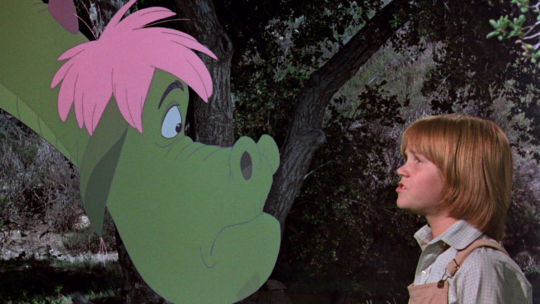
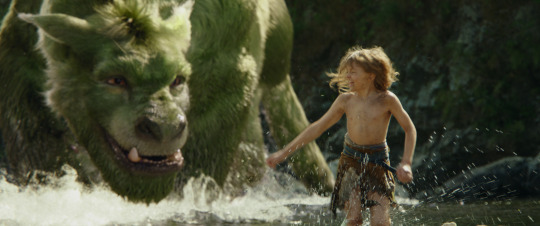
The original ‘Pete’s Dragon’ (1977) alongside the 2016 remake.
Lowery’s dragon is realized with highly realistic lighting and visual-effects work. By comparison, the cartoon-like characters in the 1977 Pete’s Dragon—along with other films listed in Louise’s handy compendium of Disney’s live-action animation—are far more exaggerated. That said, there’s still the occasional holdout for the classical version of these crossovers: this year’s Tom and Jerry replicating the look of 2D through 3D/CGI animation, specifically harkens back to the shorts of the 1940s and ’50s.
One type of live-action/animation hybrid focuses on seamless immersion, the other is interested in exploring the seams themselves. Elf (2003) uses the aberration of stop-motion animals to represent the eponymous character as a fish out of water. Ninjababy, a Letterboxd favorite from this year’s SXSW Festival, employs an animated doodle as a representation of the protagonist’s state of mind while she processes her unplanned pregnancy.
Meanwhile, every Muppets film ever literally tears at the seams until we’re in stitches, but, for the sake of simplicity, puppets are not invited to this particular party. What we are concerned with here is the overlap between hand-drawn animation and live-action scenes (with honorable mentions of equally valid stop-motion work), and the ways in which these hybrids have moved from whimsical confections to nod-and-wink blockbusters across a century of cinema.
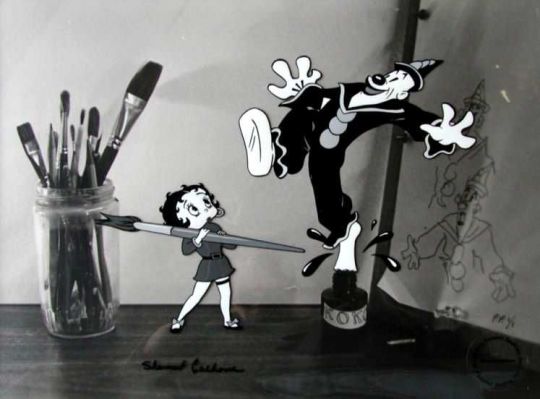
Betty Boop and Koko the clown in a 1938 instalment of the Fleischer brothers’ ‘Out of the Inkwell’ series.
Early crossovers often involve animators playing with their characters, in scenarios such as the inventive Out of the Inkwell series of shorts from Rotoscope inventor Max Fleischer and his director brother Dave. Things get even more interactive mid-century, when Gene Kelly holds hands with Jerry Mouse in Anchors Aweigh.
The 1960s and ’70s deliver ever more delightful family fare involving human actors entering cartoon worlds, notably in the Robert Stevenson-directed Mary Poppins and Bedknobs and Broomsticks, and Chuck Jones’ puntastic The Phantom Tollbooth.

Jerry and Gene dance off their worries in ‘Anchors Aweigh’ (1945).
Mary Poppins is one of the highest-rated live-action/animation hybrids on Letterboxd for good reason. Its sense of control in how it engages with its animated creations makes it—still!—an incredibly engaging watch. It is simply far less evil than the singin’, dancin’ glorification of slavery in Disney’s Song of the South (1946), and far more engaging than Victory Through Air Power (1943), a war-propaganda film about the benefits of long-range bombing in the fight against Hitler. The studio’s The Reluctant Dragon (1941) also serves a propagandistic function, as a behind-the-scenes studio tour made when the studio’s animators were striking.
By comparison, Mary Poppins’ excursions into the painted world—replicated in Rob Marshall’s belated, underrated 2018 sequel, Mary Poppins Returns—are full of magical whimsicality. “Films have added the gimmick of making animation and live characters interact countless times, but paradoxically none as pristine-looking as this creation,” writes Edgar in this review. “This is a visual landmark, a watershed… the effect of making everything float magically, to the detail of when a drawing should appear in front or the back of [Dick] Van Dyke is a creation beyond my comprehension.” (For Van Dyke, who played dual roles as Bert and Mr Dawes Senior, the experience sparked a lifelong love of animation and visual effects.)
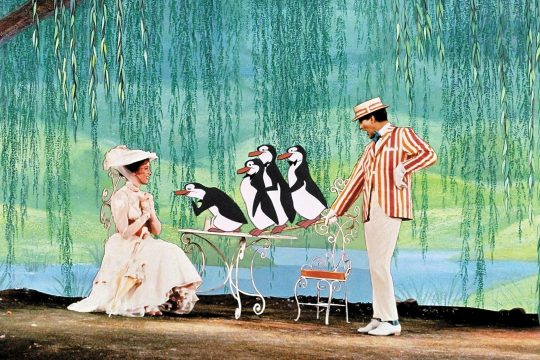
Julie Andrews, Dick Van Dyke and penguins, in ‘Mary Poppins’ (1964).
Generally speaking, and the Mary Poppins sequel aside, more contemporary efforts seek to subvert this feeling of harmony and control, instead embracing the chaos of two worlds colliding, the cartoons there to shock rather than sing. Henry Selick’s frequently nightmarish James and the Giant Peach (1996) leans into this crossover as something uncanny and macabre by combining live action with stop motion, as its young protagonist eats his way into another world, meeting mechanical sharks and man-eating rhinos. Sally Jane Black describes it as “riding the Burton-esque wave of mid-’90s mall goth trends and blending with the differently demonic Dahl story”.
Science-classroom staple Osmosis Jones (2001) finds that within the human body, the internal organs serve as cities full of drawn white-blood-cell cops. The late Stephen Hillenburg’s The Spongebob Squarepants Movie (2004) turns its real-life humans into living cartoons themselves, particularly in a bonkers sequence featuring David Hasselhoff basically turning into a speedboat.
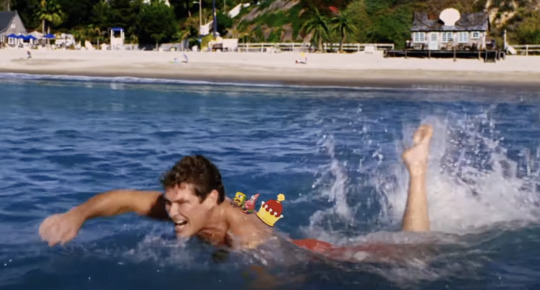
David Hasselhoff picks up speed in ‘The Spongebob Squarepants Movie’ (2004).
The absurdity behind the collision of the drawn and the real is never better embodied than in another of our highest-rated live/animated hybrids. Released in 1988, Robert Zemeckis’ Who Framed Roger Rabbit shows off a deep understanding—narratively and aesthetically—of the material that it’s parodying, seeking out the impeccable craftsmanship of legends such as director of animation Richard Williams (1993’s The Thief and the Cobbler), and his close collaborator Roy Naisbitt. The forced perspectives of Naisbitt’s mind-bending layouts provide much of the rocket fuel driving the film’s madcap cartoon opening.
Distributed by Walt Disney Pictures, Roger Rabbit utilizes the Disney stable of characters as well as the Looney Tunes cast to harken back to America’s golden age of animation. It continues a familiar scenario where the ’toons themselves are autonomous actors (as also seen in Friz Freleng’s 1940 short You Ought to Be in Pictures, in which Daffy Duck convinces Porky Pig to try his acting luck in the big studios).
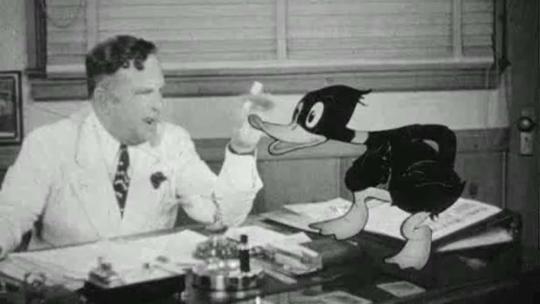
Daffy Duck plots his rise up the acting ranks in ‘You Ought to Be in Pictures’ (1940).
Through this conceit, Zemeckis is able to celebrate the craft of animation, while pastiching both Chinatown, the noir genre, and the mercenary nature of the film industry (“the best part is… they work for peanuts!” a studio exec says of the cast of Fantasia). As Eddie Valiant, Bob Hoskins’ skepticism and disdain towards “toons” is a giant parody of Disney’s more traditional approach to matching humans and drawings.
Adult audiences are catered for with plenty of euphemistic humor and in-jokes about the history of the medium. It’s both hilarious (“they… dropped a piano on him,” one character solemnly notes of his son) and just the beginning of Hollywood toying with feature-length stories in which people co-exist with cartoons, rather than dipping in and out of fantasy sequences. It’s not just about how the cartoons appear on the screen, but how the human world reacts to them, and Zemeckis gets a lot of mileage out of applying ’toon lunacy to our world.
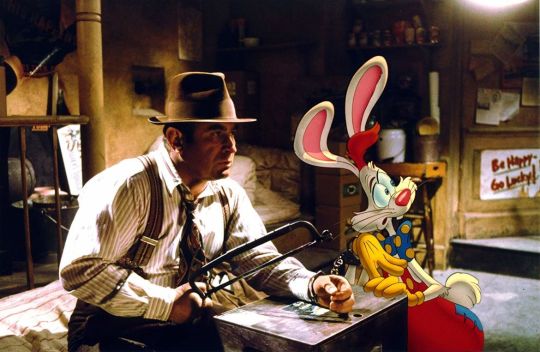
Bob Hoskins in ‘Who Framed Roger Rabbit?’ (1988).
The groundbreaking optical effects and compositing are excellent (and Hoskins’ amazing performance should also be credited for holding all of it together), but what makes Roger Rabbit such a hit is that sense of controlled chaos and a clever tonal weaving of violence and noirish seediness (“I’m not bad… I’m just drawn that way”) through the cartoony feel. And it is simply very, very funny.
It could be said that, with Roger Rabbit, Zemeckis unlocked the formula for how to modernize the live-action and animation hybrid, by leaning into a winking parody of what came before. It worked so perfectly well that it helped kickstart the ‘Disney renaissance' era of animation. Roger Rabbit has influenced every well-known live-action/animation hybrid produced since, proving that there is success and fun to be had by completely upending Mary Poppins-esque quirks. Even Disney’s delightful 2007 rom-com Enchanted makes comedy out of the idea of cartoons crossing that boundary.
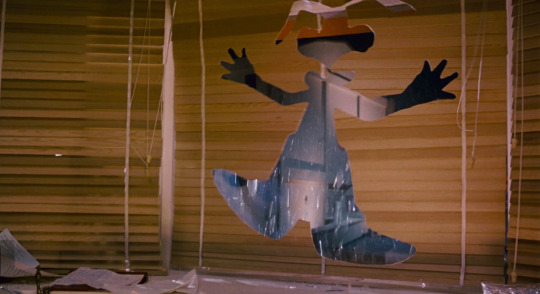
When a cartoon character meets real-world obstacles.
Even when done well, though, hybrids are not an automatic hit. Sitting at a 2.8-star average, Joe Dante’s stealthily great Looney Tunes: Back in Action (2003) is considered by the righteous to be the superior live-action/animated Looney Tunes hybrid, harkening back to the world of Chuck Jones and Frank Tashlin. SilentDawn states that the film deserves the nostalgic reverence reserved for Space Jam: “From gag to gag, set piece to set piece, Back in Action is utterly bonkers in its logic-free plotting and the constant manipulation of busy frames.”
With its Tinseltown parody, Back in Action pulls from the same bag of tricks as Roger Rabbit; here, the Looney Tunes characters are famous, self-entitled actors. Dante cranks the meta comedy up to eleven, opening the film with Matthew Lillard being accosted by Shaggy for his performance in the aforementioned Scooby Doo movie (and early on throwing in backhanded jokes about the practice of films like itself as one character yells, “I was brought in to leverage your synergy!”).
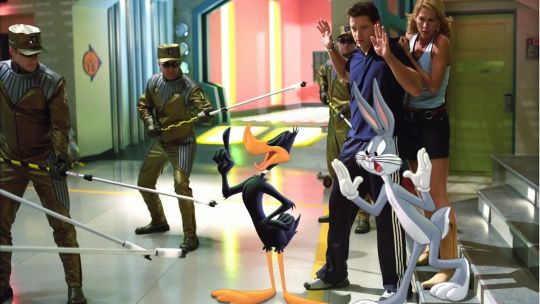
Daffy Duck with more non-stop banter in ‘Looney Tunes: Back in Action’ (2003).
Back in Action is even more technically complex than Roger Rabbit, seamlessly bringing Looney Tunes physics and visual language into the real world. Don’t forget that Dante had been here before, when he had Anthony banish Ethel into a cartoon-populated television show in his segment of Twilight Zone: The Movie. Another key to this seamlessness is star Brendan Fraser, at the height of his powers here as “Brendan Fraser’s stunt double”.
Like Hoskins before him, Fraser brings a wholehearted commitment to playing the fed-up straight man amidst cartoon zaniness. Fraser also brought that dedication to Henry Selick's Monkeybone (2001), a Roger Rabbit-inspired sex comedy that deploys a combo of stop-motion animation and live acting in a premise amusingly close to that of 1992’s Cool World (but more on that cult anomaly shortly). A commercial flop, Back in Action was the last cinematic outing for the Looney Tunes for some time.
Nowadays, when we think of live-action animation, it’s hard not to jump straight to an image of Michael Jordan’s arm stretching to do a half-court dunk to save the Looney Tunes from slavery. There’s not a lot that can be fully rationalized about the 1996 box-office smash, Space Jam. It is a bewildering cartoon advert for Michael Jordan’s baseball career, dreamed up off the back of his basketball retirement, while also mashing together different American icons. Never forget that the soundtrack—one that, according to Benjamin, “makes you have to throw ass”—includes a song with B-Real, Coolio, Method Man and LL Cool J.
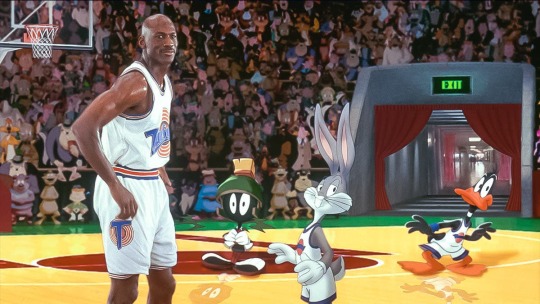
Michael Jordan and teammates in ‘Space Jam’ (1996).
Space Jam is a film inherently born to sell something, predicated on the existing success of a Nike commercial rather than any obvious passion for experimentation. But its pure strangeness, a growing nostalgia for the nineties, and meticulous compositing work from visual-effects supervisor Ed Jones and the film’s animation team (a number of whom also worked on both Roger Rabbit and Back in Action), have all kept it in the cultural memory.
The films is backwards, writes Jesse, in that it wants to distance itself from the very cartoons it leverages: “This really almost feels like a follow-up to Looney Tunes: Back in Action, rather than a predecessor, because it feels like someone watched the later movie, decided these Looney Tunes characters were a problem, and asked someone to make sure they were as secondary as possible.” That attempt to place all the agency in Jordan’s hands was a point of contention for Chuck Jones, the legendary Warner Bros cartoonist. He hated the film, stating that Bugs would never ask for help and would have dealt with the aliens in seven minutes.
Space Jam has its moments, however. Guy proclaims “there is nothing that Deadpool as a character will ever have to offer that isn’t done infinitely better by a good Bugs Bunny bit”. For some, its problems are a bit more straightforward, for others it’s a matter of safety in sport. But the overriding sentiments surrounding the film point to a sort of morbid fascination with the brazenness of its concept.
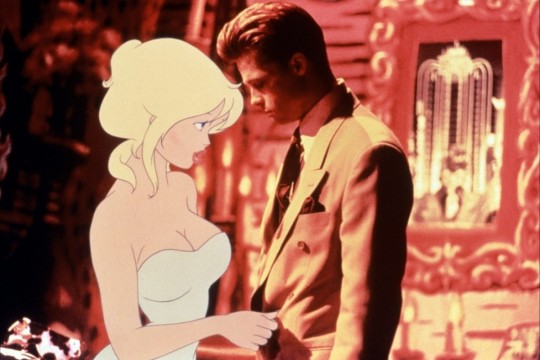
Holli Would (voiced by Kim Basinger) and Frank Harris (Brad Pitt) blur the lines in ‘Cool World’ (1992).
Existing in the same demented… space… as Space Jam, Paramount Pictures bought the idea for Cool World from Ralph Bakshi as it sought to have its own Roger Rabbit. While Brad Pitt described it as “Roger Rabbit on acid” ahead of release, Cool World itself looks like a nightmare version of Toontown. The film was universally panned at the time, caught awkwardly between being far too adult for children but too lacking in any real substance for adults (there’s something of a connective thread between Jessica Rabbit, Lola Bunny and Holli Would).
Ralph Bakshi’s risqué and calamitously horny formal experiment builds on the animator’s fascination with the relationship between the medium and the human body. Of course, he would go from the immensely detailed rotoscoping of Fire and Ice (1983) to clashing hand-drawn characters with real ones, something he had already touched upon in the seventies with Heavy Traffic and Coonskin, whose animated characters were drawn into real locations. But no one besides Bakshi quite knew what to do with the perverse concept of Brad Pitt as a noir detective trying to stop Gabriel Byrne’s cartoonist from having sex with a character that he drew—an animated Kim Basinger.
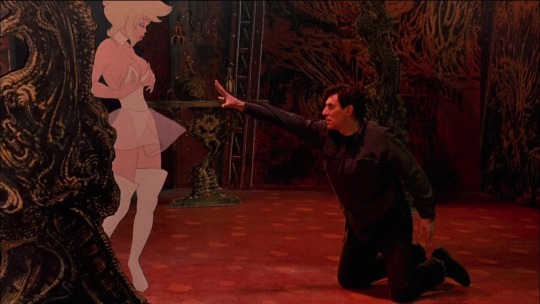
Jack Deebs (Gabriel Byrne) attempts to cross over to Hollie Would in ‘Cool World’ (1992).
Cool World’s awkwardness can be attributed to stilted interactions between Byrne, Pitt and the animated world, as well as studio meddling. Producer Frank Mancuso Jr (who was on the film due to his father running Paramount) demanded that the film be reworked into something PG-rated, against Bakshi’s wishes (he envisioned an R-rated horror), and the script was rewritten in secret. It went badly, so much so that Bakshi eventually punched Mancuso Jr in the face.
While Cool World averages two stars on Letterboxd, there are some enthusiastic holdouts. There are the people impressed by the insanity of it all, those who just love them a horny toon, and then there is Andrew, a five-star Cool World fan: “On the surface, it’s a Lovecraftian horror with Betty Boop as the villain, featuring a more impressive cityscape than Blade Runner and Dick Tracy combined, and multidimensional effects that make In the Mouth of Madness look like trash. The true star, however, proves to be the condensed surplus of unrelated gags clogging the arteries of the screen—in every corner is some of the silliest cel animation that will likely ever be created.”
There are even those who enjoy its “clear response to Who Framed Roger Rabbit”, with David writing that “the film presents a similar concept through the lens of the darkly comic, perverted world of the underground cartoonists”, though also noting that without Bakshi’s original script, the film is “a series of half steps and never really commits like it could”. Cool World feels both completely deranged and strangely low-energy, caught between different ideas as to how best to mix the two mediums. But it did give us a David Bowie jam.
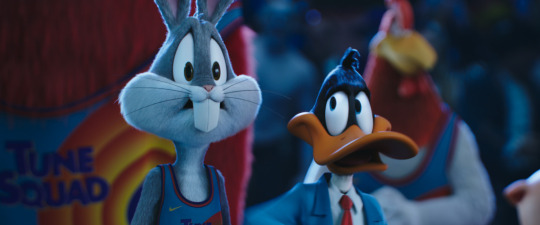
‘Space Jam: A New Legacy’ is in cinemas and on HBO Max now.
Craft is of course important, but generally speaking, maybe nowadays a commitment to silliness and a sincere love for the medium’s history is the thing that makes successful live-action/animation hybrids click. It’s an idea that doesn’t lend itself to being too cool, or even entirely palatable. The trick is to be as fully dotty as Mary Poppins, or steer into the gaucheness of the concept, à la Roger Rabbit and Looney Tunes: Back in Action.
It’s quite a tightrope to walk between good meta-comedy and a parade of references to intellectual property. The winningest strategy is to weave the characters into the tapestry of the plot and let the gags grow from there, rather than hoping their very inclusion is its own reward. Wait, you said what is coming out this week?
Related content
Rootfish Jones’s list of cartoons people are horny for
The 100 Sequences that Shaped Animation: the companion list to the Vulture story
Jose Moreno’s list of every animated film made from 1888 to the present
Follow Kambole on Letterboxd
#kambole campbell#mary poppins#ralph bakshi#hayao miyazaki#ghibli#disney#who framed roger rabbit#roger rabbit#spongebob squarepants#spongebob#animation#live action animation#live action animation hybrid#stop motion animation#stop motion#wes anderson#brad pitt#bob hoskins#genre#space jam#space jam a new legacy#michael jordan#lebron james#looney tunes#bugs bunny#daffy duck#warner bros#2d animation#letterboxd
26 notes
·
View notes
Text
Twenty First Century Slot Games
Slot machines had been invented over a century in the past, progressively proposing greater elaborate mechanisms, flashy seems, and compelling play alternatives, but it turned into the internet that took on-line slots to a completely new level. How have slot games changed as they entered our on-line world, why have been the ones innovations required, and what other modifications can gamers and on line casino owners assume cach bat lo giai 7 Online slot games made their debut almost 100 years after the original Liberty Bell slot that began it all. At first those web slots have been the clones of Las Vegas slots. The creators of the first internet slots have been so resolved to maintain the unique layout and sense that they practically replica-pasted the boxy look to our laptop display screen. The pragmatic design obstacles derived from mechanical necessity of non-virtual on line casino slots surpassingly impinged on the artistic freedom and flair that net design tools may want to have provided for those pioneering slots on line.

Granted, possibly too innovative designs may have alienated the traditional gamers, but it's miles formidable innovative method that sets internet casinos far aside from land based casinos on the subject of slot machines. After a really dull start it seemed that on line casino designers had been equipped to march the new market of gamers to the 21st century. The one-arm bandit misplaced its famous limb for stylized buttons and the conventional field frame made way for exciting 3D settings with unconventional innovations. Examples of interesting slots that display what it manner to think outside the container are CasinoLux.Com's humorous Eureka! Designed as a mad scientist's lab or the picturesque Faerie Tale slot themed as a paranormal forest wherein the symbols burst out of petals in charming animation. More accurate examples may be determined at Money-Casino.Com which include the nostalgic Drive In Slots in which the symbols are projected on movie screens, or the horror movie inspired Haunted Slots set in a grim cemetery and growing specters from the grave rather than spinning the vintage fruit reels.
A designer with a extra traditional approach might also marvel what's so first-rate approximately slot games that at a primary look do not appear like slots in any respect? Well, the human eye is hungry for marvel and novelty. That's the way it was lower back in 1895 when the first slot turned into the final scream, and it's the identical now. So how are we able to count on the 21st century participant - so acquainted with fast laptop video games and continuously bombarded with charming visual stimulation- to accept the vintage recurring? The net had injected new blood to the industry - it created the biggest marketplace ever with the aid of reaching folks who by no means had get admission to to land based casinos before. On the opposite hand, there are such a lot of on-line casinos out there. Table games can't be visually changed an excessive amount of, and consequently appearance quite comparable in exceptional casino softwares. Imaginative slots will keep a casino remembered. Fresh look and approach are worth one thousand banner ads.
The visuals need to accompany rewarding rewards. Twenty first century slot games, or video slots as they're sometimes known as to differentiate them from classic slots, recreation a superb variety of bonus functions that go away the monotony of their ancestors mild years behind: in addition to wild symbols and scatter pay, computer technology permits to create games inside video games, double-your-win bets, bonus rounds, and extra. Variation alternatives are nearly endless, and the visual effect blended with play experience is incredible.
Other than superior visuals and engaging play features the factor that make on-line slot video games higher than land based casino slot machines is they provide the ability to play for exercise at the comfort of the player's home - loose slots allow gamers to take a look at the slot system in their preference and spot for themselves if it is loose or tight. A massive selection of slots, or fruit machines as the British call them, ensures longer play time as players are often eager to attempt out the special video games and designs, continually seeking out innovative ideas.
A dependable indicator to the growing reputation of on line slots among antique-timers and beginner gamers alike is that the computerization of slots has additionally spurred the improvement of niche literature. The gamers preoccupation with slots is obvious from numerous Google searches for slots guidelines and primary online slots courses as can be observed on the increasing number of nice-selling gambling strategy books at the side of online ebooks and ezines exclusively devoted to slot games. Of direction we should no longer forget the liveliest capabilities of the Internet - forums, message boards, and groups - featuring brilliant discussions of the modern day and finest slots online, updates on new slot machines, slot tips and warnings.
What does the future keep for this enticing sport? My guess is that slots will maintain on sub-dividing to genres. Casino's game suites will must cater to the customer's thirst for variety. Traditional traditional slots (generally refers to single-reel slots, or 3-reel 1-line slots) will usually be right here, but we will see new takes at the 1-liners in sorts of bonus functions. Multiline slots will hold on breeding new traces - they even make a hundred-line slots now with a big 5,000 max wager. As talent games becoming quite a revolt I believe that on line casino software builders will provide a new type of slots as a way to characteristic extra complicated inner games and playing options that depart room for selection making, aesthetically inspired via quest video games, or maybe combat video games. Whichever new face this game may take it's going to undoubtedly stay one the most popular gambling games within the global.
0 notes
Text
How sports is Seven Worlds, One Planet: Episode 7?

Christophe COURTEAU/Gamma-Rapho via Getty Images
David Attenborough’s new show is epic ... and sports.
We continue our extremely important mission to conduct a scene-by-scene review of the BBC’s new nature documentary, Seven Worlds, One Planet, in order to see how sports it is. We determined that Episode 1, which focused on Antarctica, was reasonably sports. Asia was very sports, as was South America. Australia was more drinking than sports, and both Europe and North America were extremely sports. Now it’s time to wrap things up with ...
Episode 7 Africa
Scene 1: Nutcracking
I don’t think we appreciate how important the invention of writing is. Not only does it allow you to transmit facts (as far as I know, bookkeeping was, more or less, its original use) writing also allows the transmission of culture across time and space. Without that, animals are left passing along knowledge through direct demonstration, generation by generation. The requirement for direct contact, as you might imagine, drastically slows down the spread of knowledge.
In the Congo, a chimpanzee mother is teaching her daughter how to crack a nut. This is a relatively delicate operation. It requires finding a suitable anvil, with a nook to prevent the nut rolling around. The hammer must be the correct hardness and weight. The mother chimp makes it look easy.
Not the Nutcracker you’re used to seeing during the festive season. #SevenWorldsOnePlanet pic.twitter.com/oRTMwYz91B
— BBC Earth (@BBCEarth) December 8, 2019
But this is the ease of experience. It can take up to a decade to master the skills required to reliably crack nuts, and the five-year-old has an idea of the basic mechanics and nothing more. Trial and error is the solution, and there’s plenty of error. She tries a pebble, a boulder and a stick, to no avail. Eventually she settles on the right answer: going back to mother and having her do it.
The little chimp is too young to be a millennial but these are some highly millennial vibes.
Aesthetics 6/10
Chimpanzees are pretty cool and there’s something beautiful about watching a child learning a new skill. Even if I was worried about the poor little chimp crushing her fingers the whole time.
Difficulty 6/10
I have gone through literally hundreds of hours of wilderness survival training, and would still definitely injure myself at least twice if you gave me a rock and told me to crack nuts with it. I’m pretty confident I could eventually eat it though.
Competitiveness 0/10
No contest.
Overall 12/30
Tools are sometimes used in sports, but do not, in and of themselves, constitute sports.
Scene 2: Cuckoo Catfish
Sometimes nature documentaries show me things that totally blow my mind. This is one of those times. Lake Tanganyika’s ecosystem is dominated by cichlids, which are some of fishkind’s best parents. That may seem like a low bar, but they’re actually not bad at it. Some of the more hardcore cichlids are mouth-breeders — after laying their eggs they take them into their mouths and let them develop in a safe place. Even after the eggs hatch, the young cichlids use their mothers’ mouths as a refuge.
Nature being nature, this creates an opportunity for some dastardliness. The cuckoo catfish, like its avian namesake, is a brood parasite. And while cuckoos parasitise nests, their catfish friends manage to get their hosts to raise the catfish’s fry inside their mouths. As the cichlids spawn, the catfish eat a few of the eggs and spawn themselves. Their eggs are ingested by the mother cichlid.
A few days later ...
Peek-a-boo! I see you! #SevenWorldsOnePlanet #Wasntexpectingit pic.twitter.com/WOkBJgnugv
— BBC Earth (@BBCEarth) December 8, 2019
Yep, that’s a baby catfish. And guess what it’s going to do to its adopted brothers and sisters?
Aesthetics 2/10
I’m really quite disturbed by those baby catfish coming out of that poor mother fish’s mouth.
Difficulty 8/10
A cuckoo waiting for birds to leave their nest so that they can sneak in and lay eggs is one thing. Pulling the same trick on a fish which uses its mouth as a nest is quite another.
Competitiveness 3/10
There’s not really much of a fight here. Once the catfish arrive the little cichlids are screwed.
Overall 13/30
Cuckoldry is also not sports.
Scene 3: Cheetah Brigade
In Kenya, a cheetah family hunts as a pack. Five-strong, they can bring down prey many times larger than would be possible for a lone cheetah, but with five mouths to feed they must also hunt much more often. Using scrub as cover, the gang tries to ambush a herd of topi.
Cheetah are the fastest land animals alive, but they’re not fast enough to overcome a head start of more than a few dozen feet. That means that, once out in the open, detection could ruin the hunt. That’s what happens here: the topi scatter, the cheetahs switch targets to a nearby herd of zebra, and one promptly gets bulldozed by an angry mare.
Botched hunts aren’t just individual, momentary failures. They set the entire savannah on high alert. If the grazers know predators are on the hunt, they’re much harder to ambush. The cheetahs you can see aren’t the ones that will get you.
Incredibly, the cheetah gang uses this to their advantage. Antelope possess merely an indifferent grasp of arithmetic, so they’re well not prepared to assess just how many cheetahs they need to be keeping an eye on. So the topi end up keeping a close watch on four of the cheetahs harmlessly parading in front of them.
In formation #SevenWorldsOnePlanet pic.twitter.com/qtRyRS7Ndg
— BBC Earth (@BBCEarth) December 8, 2019
The fifth? Well, that one is behind them and about to ... yeah. The topi run away from the ambush, but they’ve let the lead cheetah get too close. The four other cheetahs join the fray, and the gang can have a nice meal. Pretty clever.
Aesthetics 9/10
That running form is really something else. Cheetah hunts are special sequences.
Difficulty 10/10
The topi hunt is difficult enough — they’re fast and beefy critters — but the use of a decoy group to catch their attention while the trap is set really elevates the whole hunt. That takes a lot of careful thinking. Good work by the cheetahs here.
Competitiveness 9/10
It takes a gang of five cheetahs plotting carefully to bring down one topi, which makes this pretty well matched.
Overall 28/30
Obviously sports.
Scene 4: Vampire Birds
Big animals (and small animals, although theirs are mostly less obvious) come with parasites. Lots of parasites. This creates a niche for parasite-feeders, which is taken up on the African savannah by the oxpecker. These little birds are more than happy to keep any big animal as free as possible from ticks, lice, and whatever else they can find.
Keeping it chill, ignoring the little dude on my face.#SevenWorldsOnePlanet pic.twitter.com/c9mq8NlQmi
— BBC Earth (@BBCEarth) December 8, 2019
Oxpeckers will go pretty much wherever food is.
Not what we meant when we said leftovers were yum. #SevenWorldsOnePlanet #didntgetthememo pic.twitter.com/OK6UxPIie5
— BBC Earth (@BBCEarth) December 8, 2019
But while you might think that having oxpeckers around to clean you up sounds quite pleasant, there turns out to be a dark side to these otherwise benign little assholes. When they eat ticks, they also get a snack of the host animals blood — and they’re more than happy to cut out the middleman, if they can.
If an oxpecker finds an open wound, they’ll peck away at it, drinking blood and preventing the wound from healing. Hippos, territorial, aggressive and armed with dental sabres, are quite good at giving each other open wounds, and oxpeckers therefore are big fans of hippos.
The hippos try to dislodge their vampiric guests by splashing water on them, which fails to deter them. They also try a hippo special: the poop helicopter. No, I’m not embedding that gif. Don’t be gross.
Aesthetics 1/10
Every creature in this scene is pretty ugly, and then we get the hippo poop storm. Why!?
Difficulty 10/10
Being a hippo-annoyer sounds like just about the most dangerous job in the world.
Competitiveness 10/10
An oxpecker against a hippo is like David vs. Goliath except also Goliath throws his poop at people.
Overall 21/30
Disgusting sports, but sports.
Scene 5: Desert Hyena
youtube
In the Namib, an abandoned mining town still has one reclusive inhabitant. A brown hyena ghosts through the broken-down buildings, using them as shade against the desert sun. And she’s not quite alone. Her twin cubs await her in their lair, four months old and hungry. The mother hyena needs to bring back some meat.
While a dead town might provide good shelter, it’s not much of a hunting ground. The Namib itself isn’t much of a hunting ground either. It is something like the oldest desert in the world, bedecked by endless dunes of sand, blasted by the tropical sun and wind. How can there be enough food to support predators of any kind?
The answer lies with the Benguela Current, off Africa’s western coast. The Benguela brings up cold, Antarctic waters, which are nutrient rich and capable of supporting a vast quantity of marine life. Some of that marine life comes to the shore.
The shore is exactly where the mother hyena is heading. Fur seals congregate here, and she’s able to pick off a baby seal and flee back towards the dunes. She’s not the only one who wants possession of her kill however; and she has to face down a jackal pack to return her prize to her family.
Aesthetics 10/10
Everything about this scene is wonderfully dystopian. Brown hyenas are also surprisingly pretty animals, with long shaggy hair which looks extremely snuggly.
Difficulty 8/10
Killing a baby seal is obviously rather trivial, but making the trek back and forth from the desert lair in scorching heat is not.
Competitiveness 10/10
The jackal pack’s late intervention really makes this scene. Five jackals against one hyena trying to bring food back to her cubs makes this very interesting indeed.
Overall 28/30
It’s official: killing baby seals is sports. If you’re a brown hyena and live in the desert. Otherwise it’s just being an asshole.
Scene 6: Termite Quest
The Kalahari, adjoining the Namib, is slightly less hostile ground. Here there is some food, if you know where to look. A lot of it is underground, in the burrows where termites make their homes. Getting in there requires some specialist tools. Some of those tools belong to the pangolin.
Licking the plate ♂️#SevenWorldsOnePlanet pic.twitter.com/0008zwp4kd
— BBC Earth (@BBCEarth) December 8, 2019
With an acute sense of smell to detect their prey and strong, claw-tipped front legs to dig them out, pangolins are specialist insectivores. (The protective scales probably don’t help them as much with their food, but they’re also pretty neat so I am listing them as well.) When a pangolin cracks upon a termite nest, that gives other critters, like small birds, a chance to get in on the action too.
But a pangolin can’t go properly underground, so they can only really scratch the surface of termiteville. Getting to the good bits requires an even more specialised termite-hunter. Say hello to the aardvark.
The aardvark is the world’s largest burrowing animal.#SevenWorldsOnePlanet pic.twitter.com/ySB7DNgxaK
— BBC Earth (@BBCEarth) December 8, 2019
Aardvarks are big, hungry and more than capable of digging to depths of ten feet or so, enough to root out even the most well-protected termite colony. They need to be, as well — an aardvark needs to eat tens of thousands of termites a day. Climate change, however, is impacting the Kalihari’s aardvarks. Droughts have reduced termite numbers, and that has placed their predators on the verge of starvation.
Aesthetics 10/10
Pangolins are objectively some of the coolest creatures on the planet and I enjoy watching them very much.
Difficulty 8/10
You try digging ten feet down with your bare hands and get back to me.
Competitiveness 2/10
It’s not shown here but soldier termites are capable of giving some pretty impressive bites, even if they’re outgunned by the pangolin and aardvark.
Overall 20/30
Probably sports.
Scene 7: Elephants
An adult bull elephant needs to eat something like 200 lbs of food per day. That would be difficult enough in times of plenty, but during droughts, when there’s little food to be had, they have to get inventive.
There is still food about, in the dried-out forests of Zimbabwe, but it’s hard to get to. Trees are producing seed pods, but they do so up on their highest branches, well out of reach of even the elephants. Packed with protein, these pods are good eating. But how to get them?
Some elephants have learned a good trick — albeit one that requires incredible strength and balance:
“He weighs over 5 tonnes. This is a truly monumental effort.”#SevenWorldsOnePlanet pic.twitter.com/6xBohrr3KO
— BBC Earth (@BBCEarth) December 8, 2019
That is some impressive stretching.
Aesthetics 8/10
Elephants are cute, but the parched forest doesn’t really do them justice compared to more verdant shots.
Difficulty 10/10
That’s a five-tonne elephant rearing back onto its hind legs. What? How?
Competitiveness 0/10
It’s not shown here but soldier termites are capable of giving some pretty impressive bites, even if they’re outgunned by the pangolin and aardvark.
Overall 18/30
Difficult enough to be a de facto sport.
Scene 8: Well This Is Depressing
To close out the series (this is our last scene!), BBC takes us on a tour of what’s going wrong with the planet. Climate change is already impacting every continent on earth. Habitat destruction is causing animal numbers to plummet. Poaching has all but wiped out some of Africa’s most majestic creatures. We are, in many ways, killing the rest of the world.
This is not merely an aesthetic question or one of being morally good versus morally not. Ultimately this is a world we all rely on, and we are contributing to its sickness. As the climate crisis deepens — climate change has been settled science since before I was born, incidentally — we will not only impact the animals showcased in this series but also deepen crises that materially affect our own communities.
Cities are starting to get close to running out of water and crop failures look increasingly likely. Sea level rise, caused by melting ice sheets on Greenland and Antarctica, will render coastal communities increasingly vulnerable to flooding. We’re already in the shit and nowhere near the worst of it.
It is our collective responsibility to mitigate this crisis as best we can. We must dismantle the structures which have allowed this to happen without consequences. We must accept that personal choice alone can’t save us in the face of rapacious behaviour from corporations. We must force our governments to confront the problem head on.
And we must also hold those responsible to account. For generations, fossil fuel companies have suppressed scientific knowledge about the damage they have been engineering and spreading misinformation instead, all in the name of profit. This is a crime against the rest of humanity, and the decision-makers involved then (and involved now) must be prosecuted and made to repay society.
The crisis is here and we cannot avert it. But there is hope nonetheless. We can lessen the damage it will do by mobilising to de-carbonise the economy, to move away from waste and greed and destruction in the name of “growth”. Mitigation now will save our children and our children’s children from the real brunt of the storm. We live in depressing times, but we ought never to forget that something can be done about them.
A better world is possible, and it is up to us to build it. Will it be hard? Obviously. Is it the only way? Yes.
0 notes
Text
Remembering the days we spent chasing congalala, understanding lifi and taking a look at Intel's AX200 wireless card

Summer is at its peak, Rain is around the corner. Soon the heavy clouds will leak, So says my trusty informer.
Between you and me as you might have perceived, but nevertheless I will come out and say it in clear terms, to remove any remaining doubt, that I’m no expert in wireless technology. The whole thing seems to me quite astonishing infact. There lies a box in the corner holding a wand. You (s)witch it on and it will send you data over the air. What sorcery is that?
However many people have pointed out to me that it is no magic. On the contrary it is a phenomenon that has been studied scientists,verified by engineers and regulated law makers. It is very much real. So I take their word for it and believe in it myself.
But technology changes so quickly. Just as we have broken the gigabit barrier in wifi a new invention has come up. LiFi or Light Fidelity a new form of communication that promises something even more incredible. To use visible light for wireless transmission. Our readers demand to know its status. We scramble for answers.
And before we could satisfactorily answer one query more questions are raised. It is in these trying times we come to accept our limitations. However we don’t let that stop us. After many hours of reading arcane specifications and trying to make sense of this rapidly progressing world of communication technology we present our thoughts to you on the matter, hoping that you’ll be so kind as to pardon the inconsistencies and factual errors that may have mistakenly crept in despite the most careful efforts of a tired staff.
What happened to LiFi technology?
Thank you for A2A. Light is an electromagnetic wave. It is already the most dominant form communication in both wireless and wired varieties. Fiber optic communication which powers today’s internet broadband service uses light. Wireless communication such as wifi [1] and Bluetooth use electromagnetic spectrum of light. TV remotes have used IR waves for switching channels.
So there is precedent in using light waves for communication in modern world.
LIFI intends to use visible light signals for wireless communication. Note the emphasis on visible light. We are not talking about radio waves here. We mean light we can see. Violet, Indigo, Blue, Green, Yellow,Orange and Red. Including UV and IR (IR as we have noted has already had a very successful implementation in remote controls for TV )
The idea is good. But the implementation is going to be tricky because of following reasons
Client support. Even if you build base stations for wireless visible light communication how are you going to get users to use them? Lot of work needs to be done in this area. There is however no reason that signals can’t be transformed from visible light to other already supported mediums like wifi to provide communication.
Visible light affects humans. So the intensity of light must be kept low. At lower intensities will the technology reduce to point to point communication? If so what happens to roaming devices? These are the questions I have not found answers to. Considering the negative press that 5G is getting for its millimeter wave , the use of UV in LIFI is going to be a PR nightmare. I can already hear cries from beauty experts on how LIFI is damaging their skin!
LIFI positions itself as a short range communication medium. That gives it protection against hackers. [2] At short range, lets say within room how can it be cheaper than a near free Ethernet cable that has universal support? Especially in the industrial application where LIFI aims to reduce electromagnetic interference. The easiest/cheapest way is to use wired communication. I might care about aesthetics in my hotel lobby. But in a workplace I want something reliable and well supported. If LIFI had increased distance transmission capacity say more than 70 M then it would have been a better substitute.
So to answer your question. LIFI is promising. But like every new invention LIFI needs to overcome technological, economical and marketing challenges. These things will take time. I’m sure that it will find a niche that will transform into a big industry. But its going to take time.
Talking about niches there’s one upcoming technology called optical computing [3](utilized in what is known as a photonic computer) that could replace electronic circuits. At the moment fiber optic cables are used to transmit light. In an optical computer therefore it would make sense that fiber optic cables would form the data transfer medium.
Here lifi technology could be utilized. In a controlled environment like inside of a CPU case you can benefit from all the positives of visible light communication while experiencing none of the negatives.
[1] Is LIFI a substitute for WIFI? https://www.quora.com/Is-LiFi-a-...
[2] “The light waves cannot penetrate walls which makes a much shorter range, though more secure from hacking, relative to Wi-Fi.” https://en.wikipedia.org/wiki/Li-Fi
[3] https://en.wikipedia.org/wiki/Optical_computing
What was your amazing experience with wireless technology?
It was raining outside. Power was out. We were supposed to be attending lecture. We skipped. I turned on my psp. My friend did the same. I had the black one. His was jet blue, slim.

We were going to hunt Congalala. He was a low level monster. An ape. Quick on his feet. Fond of fart bombing his enemies. Ice was his weakness. So we crafted out ice elemental weapons. Still he was too good for us.
We died often and when we didn’t we ran out of time. You must finish a quest within 50 minutes. Or else its game over. We were novice hunters in those days. Knew little about the habitat of the beast we were hunting. Even less about the mysterious jungle in which he dwelled.
We played and played until the battery ran out. But he got the best of us. We lost all our money. Our equipment was rendered useless. Our preparation futile. The beast won every time we attempted to take him down.
That was the start of an epic 700 hour long wireless multiplayer campaign. I haven’t felt the same way about any other game since. Even now a decade later sometimes I dream about Monster Hunter.
At that time psp was a very competent multiplayer device. A 32 bit arm 9 chip powered its 802.11b wifi. Upto 16 players could play simultaneously. But most games allowed only 4. Enabling a speed of upto 11 mbps back in 2005. It was unlike anything the world had seen before. A handheld [2]multiplayer gaming device that could stream!
Monster hunter was a sensational adhoc multiplayer success. Selling a combined total of 10M copies in japan alone.
That was 11 years ago. Multiplayer games these days need internet to work . If you don’t have a fast connection or if the server is taken down you’re out of luck. I do see a change around the corner. Game streaming is becoming more common now. We’ll need different kind of devices to [1] enable this kind of gaming. Those devices will most probably be wireless. That’s the amazing experience that I’ll be looking forward to.
[1] Return of wireless adhoc multiplayer. https://workrockin.quora.com/Ret...
[2] Nintendo Switch’s wireless capabilities look extremely promising for the future of gaming (https://workrockin.quora.com/The-wireless-features-of-Nintendo-switch)
How fast is Intel Wi-Fi 6 AX200 wireless network adapter card?
Thank you for A2A. The chip can do 2.4 gbps but only if you’re using 5ghz channel. Otherwise 573.6 mpbs on 2.4 ghz.
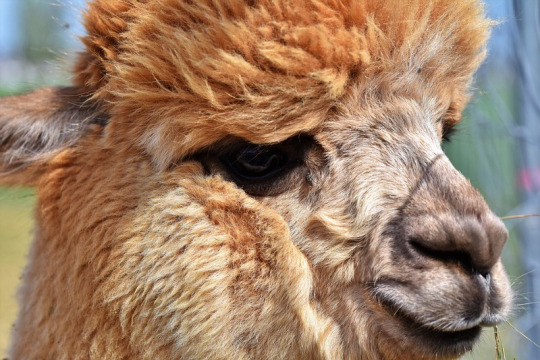
To calculate speeds look at the data rates table on wikipedia
https://en.wikipedia.org/wiki/IE...
The max speed is in the lowest column (#11) on the table. As an example assume we want to calculate the max speed of 2.4 ghz.
2.4 ghz band can have a max width of 40 mhz. And according to the spec [1] we have 2 transmitters. So the max speed in 2.4 ghz band is
2*286.8 = 573.6 mbps
Similarly 5ghz band can have a max of
2 * 1.2 =2.4 gbps
Some more details on the AX200 hardware
intel launched AX200 wifi 6 chip [1] last month. It is competitively priced between $10-$17 [2] . Before we take a look at the hardware it would be good to start with a brief on wifi 6
Wifi 6 is is technically defined by 802.11ax standard. Although it works in both 2.4ghz and 5ghz bands the highest speed in 160 mhz channel is only attainable in 5ghz band. And since 5ghz has lesser range than 2.4 ghz it means that you can only enjoy the highest speed at lesser distances. [3]
Max speed on a single radio, widest (160 mhz) channel is 1.2 gbps.
Since the standard works in both 2.4 and 5ghz bands it is backwards compatible with all other wifi standards. Which means that all your wifi client devices will work with a wifi 6 access point whether they themselves support wifi 6 or not. [3]
With that out of the way lets see what chip has for us in terms of hardware
2 transmission and 2 receive radios. Which means that we get a max throughput of 1.2*2= 2.4 gbps (note the point #2 above)
Dual band support with max channel width of 160 MHZ.
Integrated support for bluetooth 5.
Not bad for its price I’d say [4].
[1] https://ark.intel.com/content/ww...
[2] When purchased in volumes of thousands. This price is only for device manufacturers. But this is also good news for consumers because they’ll be getting the latest networking technology at cheap prices.
[3] FCC has a test report for the chip in which they specify the supported modulation schemes (page 6). BPSK, QPSK, 16QAM, 64QAM, 256QAM. Which confirms the backwards compatibility with all wifi standards.
Note that the FCC document only measures up to 256-QAM. But intel’s product page indicates a max speed of 2.4 gbps which means that it should support 1024-QAM. I’m not sure why it is not covered in the fcc document.
https://fccid.io/PD9AX200D2L/RF-Exposure-Info/RF-Exposure-SAR-Report-4213237.pdf
[4] The actual performance that you’ll achieve will also depend upon the hardware of your system. The wireless card is mostly a peripheral and its optimal performance is contingent on the capabilities of host device.
Looking for someone to help you with your wifi problems? We ar ehere to help. Email us on
write to us on our tumblr page
[https://workrockin.tumblr.com/ask]
tweet
[https://twitter.com/workrockin]
connect with us on linkedin
[https://www.linkedin.com/in/workrock-careers-21b3a2186/]
Happy networking!
Santiago,Chile
1 note
·
View note
Link
Hey - Pat from Starter Story.This week, I interviewed David Dennis, who works a full time job at Microsoft, but also runs this "surfboard-meets-art" operation on the side with his co-founder.David is a redditor (u/ventanasurfboards) and has some cool insights on growing a business.Ventana Surboards & Supplies:Name: David DennisRevenue/mo: $8,000Started: August 2014Location: Santa Cruz, CAFounders: 2Employees: 0Hello! Who are you and what are you working on?I’m David Dennis, I work for Microsoft in digital advertising, and I’m also the co-founder of Ventana Surfboards & Supplies.Creating hollow, reclaimed wooden surfboards that are pieces of art and that perform well in the waves is at the core of what we do. And, we’ve created a line of apparel and surf supplies that match the boards and that fit with our brand values: Craftsmanship. Responsibility. Adventure. We give 5% of profits back to ocean conservation organizations.We’re currently selling 10-12 boards a year at between $6000 and $9000 each to collectors and surfers alike. Our boards have tripled in value over the last three years, and we’re seeing success with our eco-apparel line and with products we’ve invented, like the Save-A-Surf Box.What's your backstory and how did you come up with the idea?My business partner, Martijn Stiphout, is our master craftsman. I photographed him for an exhibit I shot to raise money for the Surfrider Foundation Santa Cruz Chapter.I was inspired by the surfboards he was building out of reclaimed and eco-friendly materials and suggested we join forces to launch an environmentally responsible surf company ... one that could set an example for the industry.We both love to surf and to test our products in the waves with our friends and customers. Martijn and I have always been frustrated with how much surfers ignore the fact that the products and surfboards they use are highly polluting. Surfboards are mostly petroleum-based pieces of foam made with toxic resins, and clothing is generally made overseas with highly polluting processes … even surf wax often comes wrapped in plastic that can wind up in the ocean.Just go for it, but be careful about leaving a steady job just because you’ve convinced yourself that your idea is amazing.At the time that we started the business, I was working for Microsoft out of my house at the beach in Santa Cruz … I still am, in fact. I had always wanted to create a brand and to build on my business, product development, and marketing skills to do it.Martijn was spending most of his time building these incredibly beautiful wooden surfboards and bodysurfing handplanes, but he didn’t have much interest in focusing on the business operations and sales side of things. That’s what’s made our partnership so powerful. We compliment each other very well. I’m his biggest fan, and he appreciates my skills on the sales and marketing side. He’d rather work with his hands, and I’m not allowed to touch the power tools so that I can keep mine from getting cut off.We started the company with a very small personal investment from each of us. We agreed not to take on any debt and to build the company organically. We still have no debt, and we’ve been profitable from the start. We’re small, but we’d rather grow slowly and not overextend ourselves.Describe the process of designing, prototyping, and manufacturing the product.We use different approaches for different products.For instance, we invented a product called the Save-A-Surf Box out of necessity. We wanted a wooden box to keep our surf wax from melting in the car, and Martijn decided to add fin screws with an Allen wrench and a leash cord. He threw in a bar of wax and even a bottle opener and sundial.We wanted to have everything we needed to prep for a surf session in one package. And, we challenged ourselves to make it out of reclaimed and upcycled materials … which we did. It took us a few design iterations to get it right, but it’s been a very successful niche product for us.My partner, Martijn, is a self-taught woodworker. He did a lot of trial and error to finalize how our surfboards are constructed. Even so, he’s still learning new approaches to improve our shapes and designs and to make the building process more efficient.He leverages information from around the internet to master an approach that blends traditional methods with modern surfboard construction. Our boards use a wooden frame inside ⅛” veneer pieces of reclaimed wood. The rails or edges are made of cork. Add to that sheets of fiberglass and a modern, bio-based epoxy resin, and you have some of the most beautiful and sturdy surfboards in the world.Martijn uses a mix of old and new tools, as well. The inner frames are cut using a laser to exact design specs using CAD software, but some of the hand tools he uses are over 100 years old! You can see much of the process in hyperlapse here.Describe the process of launching the online store/business.We started small and tested the concept at a pop-up store we created for a holiday craft fair here in Santa Cruz.We invested in a limited run of products and showcased a few of our hollow wooden surfboards. We promoted the launch of the company, our online store, and our pop-up to happen all on the same day. We used social media and local press outreach to get the word out.The Shopify store launch went smoothly. We used an inexpensive template, and I created all the product pages and content myself over the course of a couple of weeks. Getting our first sale online the day we launched was a big deal for us. That customer has since become one of our best. We’ve even gone camping up the coast with her and showcased her as part of our Ventana Adventurers program.We realized quickly that being too overt about promoting products wasn’t working. Focus on compelling content and stories, and the sales will follow.But, by the time we registered for the craft fair, there was no space left. They let us have the outside entryway, but we had to accept the risk of inclement weather. We set up our wares and stood out in the cold. Luckily, it didn’t rain, and all the shoppers had to line up in front of the entrance before they opened the doors. That gave us terrific exposure, but the products themselves needed to be compelling enough to drive sales. They were. We did close to $10K in revenue that day. That was when we knew we’d hit on a market position and a concept that would work.I think our biggest lesson so far has been to never assume that something we think is cool will actually be a hit. We learned quickly not to create or source a lot of any one thing before testing to see if it would sell. We love the lean startup approach. Fail fast and go bigger only on the products we know will succeed. That allows us to minimize losses and maximize revenue.Since launch, what has worked to attract new customers?The woods and materials we use have very unique backstories. That attracts a good deal of press and provides compelling social media content … which in turn attracts customers.Our search engine rankings are pretty good, as well, given all of the press links. We do a bit of keyword and social media advertising, but most of our reach is organic. One of our key learnings has been to focus on telling interesting stories and showcasing the process of creating surfboards and other Ventana products on social media.People are fascinated by our craftsmanship. We realized quickly that being too overt about promoting products wasn’t working. Focus on compelling content and stories, and the sales will follow.Early on, we also realized that local collaborations with other businesses … wine and beer makers, coffee companies, belt makers, bikini makers, artists, authors and the like ... and giving back to ocean conservation groups did a great deal to help keep our story fresh and our brand front and center in the minds of our audience.We highly recommend working with other, complementary companies to create collaborative products, events, and stories. For Ventana, events are critical. We participate in craft fairs and such, but we also put on our own festivals and parties to drive sales in a fun environment that attracts new customers. We also include other vendors in those, and their participation fees have opened up a new revenue stream for us.How is everything going nowadays, and what are your plans for the future?We are growing slowly and organically, and we plan to keep it that way. My business partner, Martijn, makes a living from Ventana, but I’m doing it for the experience and because I enjoy it. Perhaps someday I’ll take a salary. But, for now, my job in tech pays the bills … and I love my work there, too.Our intention is to continue to create increasingly storied and beautiful wooden surfboards and bodysurfing handplanes along with other, surf-related products.Our boards have increased in price 3X since we started, and we expect that to continue. We’ve also built a growing, wholesale eco apparel business that drafts off of the aesthetics of our surfboards.We’d like to bring on a third partner at some point to grow that even more so that we can expand our reach outside of our local area. Wholesaling is very time consuming, and we’ll need help there in the future.Through starting the business, have you learned anything particularly helpful or advantageous?Our biggest learning has been around the value of social media marketing and of partnerships. We work with many local vendors and artists to create products and co-promote our businesses.For instance, we have a local woman uses our wood scraps to create belt buckles. Not everyone can afford our surfboards, but some of our less expensive products created in collaboration with others allow a broader customer base to join the Ventana family.We also learned early on that we need to continuously tell the larger story of our business through press, speaking engagements, and large-scale events. And, we realized quickly that telling micro-stories about Ventana every day on social media keeps our brand front and center in the minds of our audience.We showcase each step of progress on every surfboard, post about new reclaimed wood partners, involve our fans in choosing shirt designs, feature our customers and their stories and the like. We’re constantly bringing people into our world and our lifestyle through technology.What tools do you use for your business?Most critical for us have been Shopify and Instagram, but the list of technology and services we use is incredibly long … surprisingly so for a company that, at its core, creates handmade wooden surfboards. I actually did a presentation on that topic recently.We’re continuously testing new tools, marketing technology, online advertising approaches, Shopify apps, and the like.We’ve seen the most revenue success through organic, unpaid Instagram posts. And, we also rely on MailChimp, Facebook, Twitter, and Reddit. We leverage Houzz, YouTube, Pinterest, LinkedIn, Survey Monkey and a few smaller reach platforms, as well.We also use Shopify Point of Sale, Etsy, Microsoft Windows, iPad, Android, iPhone, QuickBooks Online, Microsoft Office, OneDrive, Google Apps, Photoshop and other creative and productivity tools.We integrate the Shopify store with Instagram and Facebook so that customers can shop from posts. Our success with that approach is ramping.We’ve also leveraged a variety of Shopify apps. We use Facebook Chat by Beeketing, MailChimp for Shopify, HelpCenter for our FAQ, ShipStation, Plug in SEO and Minifier.What have been the most influential books, podcasts, or other resources for your business?I love the books First Break All the Rules, the Cluetrain Manifesto and The Lean Startup. The lessons learned from those books about focusing on your strengths, remembering that markets are conversations, and that continuous iteration is the key to success have been instrumental.I get a lot of value out of the Shopify Blog, as well as various business-related threads on Quora. I’ll also occasionally go back and watch my TEDx talk called “Don’t Quit Your Day Job” whenever I think about doing that!Advice for other entrepreneurs who want to get started or are just starting out?Just go for it, but be careful about leaving a steady job just because you’ve convinced yourself that your idea is amazing.Start small, test your concept, and iterate your way into success or failure before doing something drastic that could negatively impact your long-term financial health and happiness.Making a 100 widgets and selling out quickly is better than manufacturing 10,000 and selling that same 100 count. Think through what the small steps are that you can take to make sure you’re on the right track before expanding.Also, be honest with yourself about your weaknesses and partner or hire people who can fill those gaps. And, if you’re not sure what your weaknesses are, ask people you trust to be honest with you. If you’re great at sales, focus there. If you’re terrible at marketing, hire!Learn more about Ventana Surfboards - their website is ventanasurfboards.com, or find them on Instagram, and Facebook.
0 notes